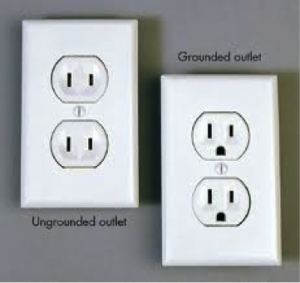
If you’re trying to sell a home, you may be surprised to hear the home inspector report that your 3-wire receptacles (the “monkey face” outlets) aren’t actually grounded.
This occasionally happens in older homes. At some point, someone simply replaced the old ungrounded 2-wire receptacles with new 3-wire receptacles—often because they have equipment with 3-wire cords and it’s simply inconvenient to purchase adaptors—but didn’t actually ground the connections.
When that happens, and the house goes up for sale, triggering a home inspection report, the home inspector must report such a condition. What’s the seller to do?
You could re-wire to provide the 3rd wire to properly ground the 3-wire receptacles—a relatively expensive solution, and that may be what the buyer wants. And in an ideal world, that is indeed the best solution.
GFCI (Ground-Fault-Circuit-Interrupting) receptacles—the ones with the push buttons—are an option, and a much less expensive solution. Believe it or not, they are approved by the National Electrical Code and considered, in effect, safer than having the 3-conductor wiring.
We have done this in several instances. Sometimes, though, we still get written up by the home inspector, or questioned by others who don’t understand how and why this is an acceptable solution. One reason is that when a GFCI is wired on the 2-wire system are tested with a GFCI tester, they don’t “trip” for the tester, even though the button will trip it.
Correctly-functioning GFCIs will trip when the button is pushed. However, when the 3rd wire (connected to the round hole, the “mouth” of the “monkey-face” configuration) is not connected, the GFCI will not trip when checked with a correctly-functioning GFCI tester. The reason for this is that the tester puts the receptacle on true ground-fault test condition (while the buttons merely check the trip function itself). Note also that only one light, the “hot” wire indicator, will light, rather than two, as with a correctly-wired 3-wire receptacle.
For a GFCI to trip under test conditions or actual ground-fault conditions, part of the incoming current (fed in through the black wire onto the brass screw) must be divided between its correct path (back through the white wire via the silver screw) and some other pathway, e.g., a person who would, without a GFCI, experience at least a tingle. Since there is no true path for this to occur (there is no path from the 3rd connecting point), the GFCI will not trip.
This is not—I repeat NOT—a safety concern, so long as the trip function works properly. NEC (National Electrical Code) allows non-grounding type receptacles (i.e., 2-wire receptacles) to be replaced with a GFCI receptacle, per §406.3(D)(3)(b), or a 3-wire receptacle protected by a GFCI receptacle per section §406.3(D)(3)(c). In fact, it is possible that such wiring is actually safer than 3-wire systems without GFCI because of how GFCIs operate under ground-fault conditions. GFCI tolerances are typically set to trip at 0.004-0.008 amps (the amount of current required to kill a person is 0.035 amps). This, of course, is true only so long as the GFCI is working properly—and GFCIs have been known to have as much as a 12% failure rate.
Obviously, re-wiring is preferable. But if it means saving several thousand dollars, and if you’re a seller who’s already taken a beating from being on the market too long or being in a tight situation, this may be one of the most cost-effective solutions.
And, of course, if you decide to ignore the “Do not try this at home!” BE SURE TO TURN THE POWER OFF BEFORE! (And be sure to put the BLACK wire on the BRASS, WHITE on the SILVER.)
We’ll Never Leave YOU In The Dark!
